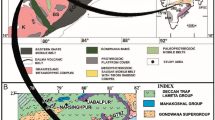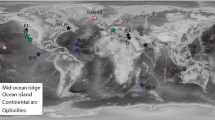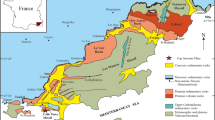Abstract
Evidence is available that some elements, notably Zr, TiO2, Y, Sc, Ce and Nb are largely immobile during the alteration of volcanic rocks owing to metamorphism, hydrothermal events and weathering (e.g. Floyd and Winchester, 1978). However, it is shown, by reference to analyses of rocks from the environment of five volcanogenic massive sulphide bodies, that while Zr, TiO2 (and Ce?) are mostly immobile even during intense hydrothermal alteration, Y and particularly Sc and Nb may be extremely mobile. When elements are removed by solution in a hydrothermal fluid it seems that reaction rates are such that these elements are almost totally removed from the rock. Therefore, of the so-called immobile trace elements, only Zr and TiO2 may be used with any reliability to identify the degree of magmatic differentiation in an hydrothermally altered rock. However, if an element has been mobile it is usually readily identified as having moved.
Similar content being viewed by others
References
Burton C C T (1975) Rosebery zinc-lead-copper orebody: In K. Knight (ed) — Economic Geology of Australia and Papua New Guinea 1. Austral Inst Min Metal 619–627
Corbett K D, Reid K O, Corbett E. B, Green G R, Wells K, Sheppard N W (1974) The Mount Read Volcanics and Cambrian-Ordovician relationships at Queenstown, Tasmania. J Geol Soc Aust 21: 173–186
Floyd P A, Winchester J A (1978) Identification and discrimination of altered and metamorphosed volcanic rocks using immobile elements. Chem Geol 21: 291–306
MacGeehan P T, MacLean W H (1980) An Archean sub-seafloor geothermal system, ‘calc-alkali’ trends, and massive sulphide genesis. Nature 286: 767–771
Reid K O (1975) Mount Lyell copper deposits. In: Knight K (ed) Economic geology of Australia and Papua New Guinea 1. Austral Inst Min Metall 604–619
Solomon M (1962) Tectonic history of Tasmania; In: Geology of Tasmania Spry A M, Banks M R (eds) J Geol Soc Aust 9:311–339
Wilcox R E (1979) The liquid line of descent and variation diagrams; In: Yoder H S (ed) The evolution if igneous rocks. Princeton University Press, Princeton, 205–232
Winchester T A, Floyd P A (1977) Geochemical discrimination of different magma series and their differentiation products using immobile elements. Chem Geo 20: 325–347
Author information
Authors and Affiliations
Rights and permissions
About this article
Cite this article
Finlow-Bates, T., Stumpfl, E.F. The behaviour of so-called immobile elements in hydrothermally altered rocks associated with volcanogenic submarine-exhalative ore deposits. Mineral. Deposita 16, 319–328 (1981). https://doi.org/10.1007/BF00202743
Received:
Issue Date:
DOI: https://doi.org/10.1007/BF00202743




